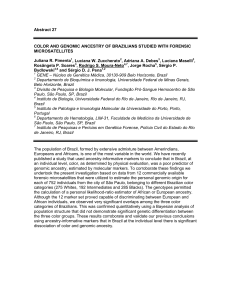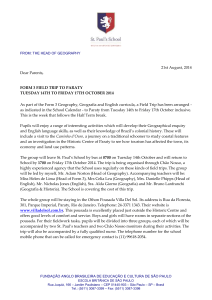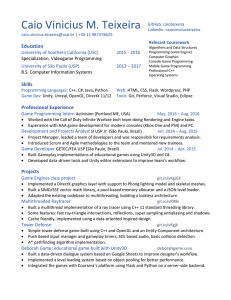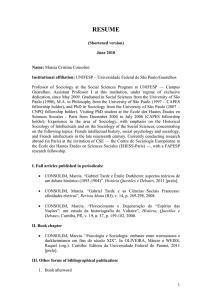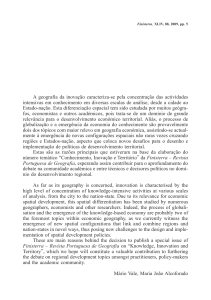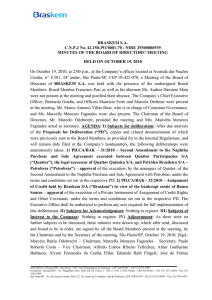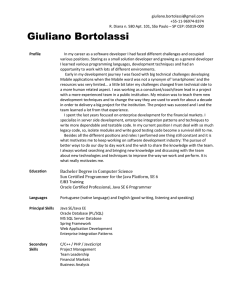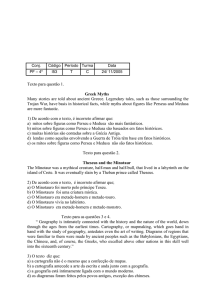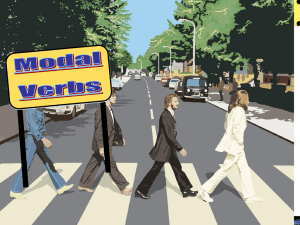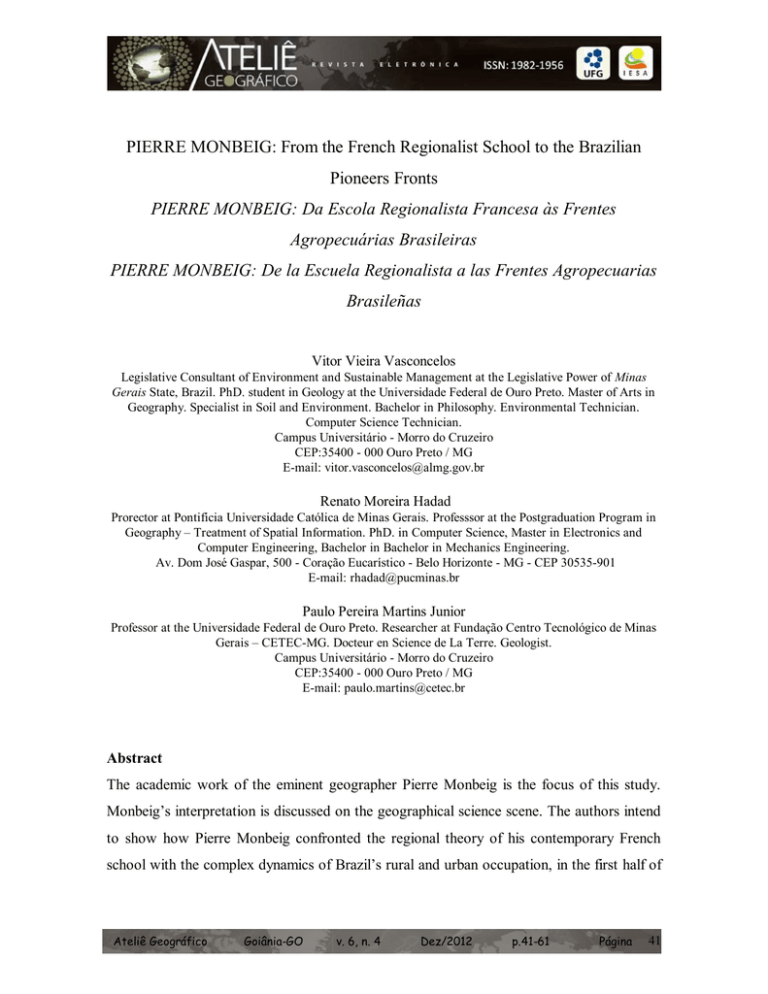
PIERRE MONBEIG: From the French Regionalist School to the Brazilian
Pioneers Fronts
PIERRE MONBEIG: Da Escola Regionalista Francesa às Frentes
Agropecuárias Brasileiras
PIERRE MONBEIG: De la Escuela Regionalista a las Frentes Agropecuarias
Brasileñas
Vitor Vieira Vasconcelos
Legislative Consultant of Environment and Sustainable Management at the Legislative Power of Minas
Gerais State, Brazil. PhD. student in Geology at the Universidade Federal de Ouro Preto. Master of Arts in
Geography. Specialist in Soil and Environment. Bachelor in Philosophy. Environmental Technician.
Computer Science Technician.
Campus Universitário - Morro do Cruzeiro
CEP:35400 - 000 Ouro Preto / MG
E-mail: [email protected]
Renato Moreira Hadad
Prorector at Pontifícia Universidade Católica de Minas Gerais. Professsor at the Postgraduation Program in
Geography – Treatment of Spatial Information. PhD. in Computer Science, Master in Electronics and
Computer Engineering, Bachelor in Bachelor in Mechanics Engineering.
Av. Dom José Gaspar, 500 - Coração Eucarístico - Belo Horizonte - MG - CEP 30535-901
E-mail: [email protected]
Paulo Pereira Martins Junior
Professor at the Universidade Federal de Ouro Preto. Researcher at Fundação Centro Tecnológico de Minas
Gerais – CETEC-MG. Docteur en Science de La Terre. Geologist.
Campus Universitário - Morro do Cruzeiro
CEP:35400 - 000 Ouro Preto / MG
E-mail: [email protected]
Abstract
The academic work of the eminent geographer Pierre Monbeig is the focus of this study.
Monbeig’s interpretation is discussed on the geographical science scene. The authors intend
to show how Pierre Monbeig confronted the regional theory of his contemporary French
school with the complex dynamics of Brazil’s rural and urban occupation, in the first half of
Ateliê Geográfico
Goiânia-GO
v. 6, n. 4
Dez/2012
p.41-61
Página
41
the twentieth century. Therefore, Monbeig pointed out that new ways were necessary to
think as a geographer.
Keywords: Pierre Monbeig; Geography History; Pioneers Front, Brazil.
Resumo
Este artigo tem como objetivo discorrer o geógrafo Pierre Monbeig. O prelo comenta suas
posições sobre a ciência geográfica. Pretende-se mostrar, como Pierre Monbeig,
confrontando a teoria da escola regionalista francesa com a complexidade da dinâmica
brasileira de ocupação rural e urbana da primeira metade do século XX, mostrou serem
necessárias novas formas de se pensar a Geografia.
Palavras-Chave: Pierre Monbeig; História da Geografia; Frentes Agrícolas, Brasil.
Resumen
Esto artículo tiene como objetivo discutir acerca de el geógrafo Pierre Monbeig. Al
principio, expone sus posiciones acerca de la ciencia geográfica. Consiguiente, muestra
como Pierre Monbeig, confrontando la teoría de la Escuela Regionalista Francesa con la
complexidad de la dinámica de la ocupación brasileña urbana y rural de la primera mitad del
siglo XX, demostró la necesidad de nuevas formas de pensar la Geografía.
Palabras-clave: Pierre Monbeig, Historia de la Geografía, Frente Agrícola, Brasil.
Introduction: Life and Work
Pierre Monbeig (1908-1987) lectured in Brazil from the 1930s to the 1940s. His chair at
USP (Universidade de São Paulo – University of São Paulo) followed that of Pierre
Deffontaines, assuming the task of continuing the implantation of academic Geography in Brazil
(BARREIRA, 1995, p. 92). As one of the first academic professors of Geography in Brazil, he
took part in the education of many important researchers, such as Aziz Ab’Saber and Caio Prado
Júnior. Furthermore, after returning to France, he would be tutor of many Brazilian geographers
who went to that country seeking their PhD degree (AB’SABER, 1994, p. 222). Thus, his work
Ateliê Geográfico
Goiânia-GO
v. 6, n. 4
Dez/2012
p.41-61
Página
42
contributed, together with other geographers, to the consolidation of Geography as an academic
knowledge in Brazil, as well as to valorize the Geography professionals as technicians or teachers
at schools, companies and institutions (BARREIRA, 1995, p. 93).
Monbeig had his academic education at the French regionalist school, with Vidalian roots
(SILVA, 2002, p. 71). His major masters were Albert Demangeon and Emmanuel de Martone,
although he was also influenced by the historical economic lectures of Henri-Hauser (SILVA,
2002, p. 75). Bray (1983, p. 84-85) identifies some characteristics of the French Geography that
were incorporated by the works of Monbeig: esteem of freedom and human initiative; the
systemic-organicist approach; the theory of balance between humankind and nature; the utility of
Geography as an advisory service to the government; and the esteem of solidarity as a social
weaver. The latter is exemplified below:
Solidarity is a principle of the political liberalism and a contraposition to the
competitive evolutionism with Darwinian-Ratzelian basis. The solidarity is a
fundamental principle in the studies of the ways of life and in the functionalist
analysis carried out by the French Geography. (BRAY, 1983, p. 84)1
Pierre Monbeig was very active regarding his academic production. Before the existence
of academic Geography journals in Brazil, Monbeig had published several articles in the
newspaper Folha de São Paulo. Later, many of these articles were republished in academic
journals (AB’SABER, 1994). A comprehensive biographic chronology of Pierre Monbeig’s
publications is presented by Salgueiro et al. (2002).
After returning to France, Monbeig lectured for a short period in Strausbourg (19481952) and then became a professor at the Conservatoire National de Arts et Métiers, in Paris.
His participation in the foundation (1957) and direction of the Institut des Hautes Études de
L’Amérique Latine (IHEAL) is noteworthy. The IHEAL developed many researches about Brazil
1Our translation of: “A solidariedade é um princípio do liberalismo político e uma contraposição ao
evolucionismo competitivo concorrencial de base darwinista-ratzeliana. Nos estudos dos gêneros de vida e
nas análises de tendências funcionalistas da geografia francesa, a solidariedade é um princípio fundamental.
(BRAY, 1983, p. 84)”
Ateliê Geográfico
Goiânia-GO
v. 6, n. 4
Dez/2012
p.41-61
Página
43
and other Latin American countries. Monbeig also had a memorable participation at the Centre
National de la Recherche Scientifique (CNRS), where he held several high positions, until his
old age. Monbeig died on September 22, 1987 (SALGUEIRO et al., .2002, p. 33).
The contribution of Pierre Monbeig to the Brazilian Geography is notable, as well as his
contribution to the Geographic Science in a broader sense. This paper aims to present the
thoughts of this author, focusing specially on his contribution to the study of Brazilian pioneer
farming fronts. Moreover, this paper intends to show how Monbeig’s experience with the
Brazilian territory allowed him to contribute to the development of new ways of thinking the
Geographic Science.
Monbeig’s Thoughts on Geography
In 1940, Monbeig published his first book about Geography in Brazil. The book was
called “Essays on Brazilian Human Geography” (Ensaios de Geografia Humana Brasileira). In
this book, he discussed, with criticism, broad themes of Geography, such as the definitions of
what this science is and its relationship with landscapes, with literature and with civilization.
Furthermore, Monbeig added contents from the Brazilian Geography to these discussions,
writing about the São Paulo State, about the western pioneer front of Brazil, about the cocoa
plantations in the Bahia State, and also about the Geographic academic movement in Brazil
(AB’SABER, 1994, p. 229). Special attention should be paid to his observations about the
interaction among the Brazilian rural occupation with the natural landscapes. Monbeig used these
observations as examples for his conclusions on how the humans transform the natural space into
landscapes with human subjective contents (SILVA, 2002, p. 73).
Later, in 1957, Monbeig published another book, called “New Studies on Brazilian
Human Geography” (Novos Estudos de Geografia Humana Brasileira). In this book, he
presented many articles, where he exposes important reflections upon the geographic thought;
this time, with the aid of his broader experience on Brazilian geographic studies. Monbeig will
defend themes like the value of explanatory attitudes in the study and teaching of Geography; the
importance of psychology and the way of thinking of the communities, implying the manner of
relating to their territory; relations of the international capital flows with the regional
development; as well as important considerations for the study of agrarian and urban Geography.
Ateliê Geográfico
Goiânia-GO
v. 6, n. 4
Dez/2012
p.41-61
Página
44
In all the articles of this work, the examples and studies related to the Brazilian context
are remarkable, such as in-depth researches about the city of São Paulo and the pioneer fronts of
the west of São Paulo State. The depth and consistency of Monbeig’s reflections are due to the
unity between his practical experience of the changes on his time, as a geographer/researcher,
and his new reflections on the theory of Geography.
Pierre Monbeig had, as a professional character, a critical and sometimes explosive
behavior against works that he would consider insipid and trivial (AB’SABER, 1994, p. 226227). He is also remembered, by his former students, for how much he cared about field work for
regional rural studies and urban geography (AB’SABER, 1994, p. 226-227). He would assign
his students to missions of developing regional studies around the university (USP), as a way to
initiate them into the authentic geographic praxis.
Monbeig argued that a deep, direct contact with the reality was necessary before
theorizing upon it (AB’SABER, 1994, p. 226). In a country such as Brazil in the beginning of the
twentieth century, with few statistical and cartographic data, this experience was even more
relevant (SILVA, 2002, p. 75). Furthermore, it would be useful, as much as possible, to have
direct contact with other similar regions, for comparative reflections. This is shown by Silva
(2002) when he presents the following quotation of Pierre Monbeig:
In order to better understand the problems regarding the Amazon, I think that it
is very important to understand the situation of other similar regions around the
world. All the Equatorial Africa is very similar to the Amazon. They are not
exactly equal, because equality exists only in Mathematics. But the similarities
are very evident…2
According to Pierre Monbeig, hasty theorizations, or even theorizations based on
secondary data, without the necessary prior contact of the researcher with the region studied,
would lead only to infertile, erroneous and prejudiced formulations. Good geographers, on the
2 Our translation of: “Para se compreender melhor o problema da Amazônia, acho muito importante
conhecer a situação existente em outras regiões similares do mundo. Toda região da África Equatorial é
bastante parecida com a Amazônica. Não são rigorosamente iguais, porque só em Matemática existe a
igualdade. Mas as semelhanças são muito grandes ...” (Pierre Monbeig, apud Silva, 2002)
Ateliê Geográfico
Goiânia-GO
v. 6, n. 4
Dez/2012
p.41-61
Página
45
contrary, would take the best advantage of the contact with the landscape. They would observe,
feel, inquire people, i.e., deeply perceive what, for others, would be just common sceneries
(SILVA, 2002, p. 72). In this undertaking, a skillful perception is essential to identify the most
diverse elements, with their different constitutions and scales, encompassing the lines of the
relief, the geological inferences, the understanding of the ecosystems, and also the sensibility to
the implicit subjectivity and sociality inherited in landscapes that have already been touched by
humans (SILVA, 2002, p. 72). That was the recommendation of that professor for his students,
as guidance for their future works as geographers.
Monbeig agreed that, preliminarily, the analytic description of a region could be useful,
discriminating reality through physical descriptions, technical information, social and economic
statistics, and everything else (MONBEIG, 1952). However, the geographer work does not stop
there. Additionally, the most important would be the subsequent undertaking, dedicated to build
an understanding of the processes that relate all those parts and views of a complex that is being
studied (MONBEIG, 1957, p. 14). In this way, Geography would then be able to go beyond the
simple description of places and data; thus, reaching a truly explanatory scientific attitude,
necessary both to the research and to the teaching of Geography (MONBEIG, 1952; 1957).
The most singular characteristic of the geographer would be this one: working with many
aspects of a region in an integrative approach. Aspects that, otherwise, could just be analyzed
separately, by different specialists. Monbeig said that, due to this integrative approach, the
geographer object of research is the geographic complex (MONBEIG, 1957, p. 11; SILVA,
2002, p. 72). The following quote, from Monbeig (1957, p. 24), illustrates well the integrative
role of the geographer inside interdisciplinary groups (BARREIRA, 1995, p. 103):
Let us hypothesize that a government decided to scientifically study the
colonization possibilities of the semi-arid regions of the Amazon or the Central
Brazil. The study would be assigned to a group of researchers: soil scientists,
geologists, agronomists, hygienists, as well as economists, sociologists, transport
technicians; and geographers. To these last ones, lies the mission to harmonize
Ateliê Geográfico
Goiânia-GO
v. 6, n. 4
Dez/2012
p.41-61
Página
46
the viewpoints of all the other professionals. This role is complementary to the
specialized studies, but will allow the indispensable synthesis. 3
Monbeig used to criticize the usage of the concept of Applied Sciences to define
Geography or any other science. He argued that every body of knowledge is useful to our lives
and, actually, the abusive misusage of the expression Applied Sciences would have been used as
an excuse for some university professors in order to hide themselves into their projects in their
departments and laboratories, fleeing from the academic dialogue (AB’SABER, 1994, p. 231).
As an alternative to that isolation, Monbeig asserted that scientific progress should happen
through disciplinary and interdisciplinary academic dialogue. Therefore, he would conclude that
the possibilities of more efficient and practical appliance of sciences would increase in the extent
that all branches of Science develop jointly.
Brazil (MONBEIG, 1954)
In his book Brazil, Monbeig writes about the Brazilian environment, its society and, also,
about the spread of the Brazilian occupied area along history. In the chapter about the natural
environment, he synthesized the knowledge available about the Brazilian territory, presenting
information and maps about climate, vegetation, geology, topography and soil types.
In the following chapter, Monbeig deals with the Portuguese conquest of Brazil. He starts
analyzing how the Native South Americans occupied Brazil before the continent was discovered
by Europeans. Then he writes about the relationship of the Portuguese colonizers with the Native
South Americans, through religious settlements, but also mainly through expeditions that sought
to imprison the natives as slaves. This explains how the Native South American nations were
annihilated along the history of Brazil, being expelled from their land by the Portuguese colonists,
3 Our translation of: “Suponhamos que se resolva proceder ao estudo científico das possibilidades de
povoamento nas regiões semi-desérticas da Amazônia ou do Brasil Central. O estudo será entregue a grupos
de pesquisadores – pedólogos, geólogos, agrônomos, higienistas; outros serão economistas, sociólogos,
técnicos de transporte; outros geógrafos. A estes cabe contribuir para a harmonização dos pontos de vista dos
técnicos. Seu papel será complementar, mas permitirá a síntese indispensável.” (MONBEIG, 1957, p. 24).
Ateliê Geográfico
Goiânia-GO
v. 6, n. 4
Dez/2012
p.41-61
Página
47
and also being decimated by enslavement, European diseases and warfare. Nonetheless, Monbeig
remarks that the Native South American has influenced the Brazilian culture in many ways,
regarding language, food and artwork, especially for the rural peoples who live in isolated sites.
Sequentially, Monbeig goes on exposing the details of the Portuguese occupation of
Brazil. Initially, he comments on the sugar cane cycle and the arriving of the African slaves. After
that, the chapter goes through the gold and diamond cycle, which starts with the expeditions
departing from São Paulo State and finishes with the peopling of Minas Gerais, Goiás and Mato
Grosso states, to where many of the colonists and their slaves migrated. Throughout that period,
the agriculture and the cattle breeding developed in the São Francisco River Valley and in the
Southern Brazil, to supply the main economic activities of each cycle – whether for sugar cane
farms or for mining towns.
Monbeig points out that, during the Brazilian development process, a society with
markedly unequal classes took place, in which land owners and wealthy merchants contrast with
an impoverished mongrel society which include caboclos (hillbillies), natives, mulattos, niggers
and white people.
Following the gold cycle, Monbeig describes the expansion of land occupation with
mono-culture plantations for the export market. The mono-culture cycle reaches its apex with the
expansion of the coffee plantations in São Paulo State. With the gradual abolition of slavery, a
large-scale immigration started in order to fill the job places in Brazil, completing the
miscegenation framework of the Brazilian people. In this way, the Brazilian colonists went on
occupying new lands, further and further, not only because of the increasing world demand for
food, but also due to the depletion of land fertility by the outdated production techniques, which
were being used. It was only possible to rehabilitate these depleted farms after many decades,
with the advent of new agriculture techniques.
The author discusses the occupation of Northern Brazil, by the Latex extraction, and also
the occupation of Southern Brazil by European immigrants. Furthermore, he highlights how the
Central Brazil was starting to stand out in the cattle supply for Southeastern Brazil. With such
descriptions, Monbeig tried to portray a broad frame of the Brazilian territorial formation.
As a closure for his book, Monbeig proposes the analysis of the urbanization and
industrialization, which had developed with the surplus money from the agriculture production.
This new society was facing challenges never seen before, such as demographic outbreak, rural
Ateliê Geográfico
Goiânia-GO
v. 6, n. 4
Dez/2012
p.41-61
Página
48
exodus, as well as the demands for energy and transport infrastructure. Moreover, a new political
scenario was taking place, still dependent on the landlords of the countryside, but with a new
national integration, as well as with geopolitical disputes among the Brazilian regions for
hegemony in the government.
Regarding the process of Brazilian territorial formation, Monbeig emphasizes the need to
understand how the Brazilian history was influenced by the transformations and demands from
Europe and America, both on production and on culture. Through international contextualization
and through the study of the technical-productive, social, cultural and geographic details of
Brazilian occupation process, the book Brazil became a pioneering milestone in the study of the
Brazilian territorial formation.
Pierre Monbeig, in his book “Novos Estudos de Geografia Humana Brasileira” (New
Studies on the Brazilian Human Geography), explored these topics further regarding the
relevance of the international context analysis to understand the situation of Brazil and other
nations. In the chapter Capital and Geography, he went through questions about how the
investments of international banks, as well as international trade relations, were becoming
increasingly important for the trends on the increase of land occupation and on the technical
production processes in rural and urban areas, especially in Brazil. In another chapter of the same
book, he argues that attention to the international economic conjuncture should be given even in
the Geography lessons in elementary school. These basic teachings would help the citizens to
become more aware of how the international processes are directly related to the economic
development and the quality of life in their countries (MONBEIG, 1957, p. 18).
Pioneers and Farmers in São Paulo State (MONBEIG, 1952)
Since Pierre Monbeig arrived in Brazil, he became very interested in the vivacity of the
pioneer fronts in São Paulo State. The never ending relationship between the territorial
occupation and the economic development in the west of São Paulo instigated Monbeig to
propose his PhD. thesis on this theme (AB’SABER, 1994, p. 230). That was a challenging theme
for the French Regionalist Geographical Science, because the ever-changing situation of the
Brazilian occupation, as well as the cultural miscegenation, were creating spatial processes that
were very different from the ones in the relatively stable French rural landscapes (SILVA, 2002,
Ateliê Geográfico
Goiânia-GO
v. 6, n. 4
Dez/2012
p.41-61
Página
49
p. 75). After this first contact, Monbeig would keep studying and dealing with the Brazilian
Geography throughout his academic life.
In the book “Pioneiros e Fazendeiros de São Paulo” (Pioneers and Farmers in São
Paulo), Pierre Monbeig undertakes a study that owes significantly to his background in French
Regional Geography. As one of the founders of the geographic school in Brazil, his work
generated a framework for the following academic studies on the Brazilian territory. Besides that,
the book is also an important synthesis of knowledge about this important phenomenon for the
history of the Brazilian territorial formation, which is the expansion of the coffee crop fronts
through the São Paulo state. A notable characteristic of that study was the conjugation of modern
academic theories, field observation and experience, as well as statistical and cartographic
surveys that were available at that time (AB’SABER, 1994, p. 229).
As a traditional regional study, Monbeig begins by researching about the natural
characteristics of the area studied. He describes the relief, the climate, the soils and the natural
vegetation landscapes of São Paulo state and adjacencies.
The author discusses the historical conditions, which gave rise to the current structure of
society in São Paulo state and its land use. Thus, the author focuses on three lines of argument:
the historical description, the analysis of economic factors and, lastly, what he calls “psicologia
bandeirante” (pioneer psychology).
The pioneer psychology would be a remarkable innovation, mainly because it regards a
research approach that had not been well accepted by the academic society of Geography at that
time (SILVA, 2002, p. 78). While presenting this theory, the author reflects on a particular way
of thinking of a certain group of people who, from the landowners of the oligarchy to regular
farmers, play an almost heroic role in exploring and settling in a virgin land, developing their
country and consequently, giving rise to a new world of dreams and opportunities
(GONÇALVES, 1998, p. 52). It is possible to note these characteristics in the following quote
from the book “Pioneiros e Fazendeiros de São Paulo” (Pioneers and Farmers in São Paulo) (p.
122-123):
There is a kind of instinct in Brazilians, mainly in those from Minas Gerais and São
Paulo states, which stimulates them to go forward, beyond the civilization. (…) The
wish for solitude and the vocation to fight may be fulfilled as there are vast lands
Ateliê Geográfico
Goiânia-GO
v. 6, n. 4
Dez/2012
p.41-61
Página
50
available to everyone. Vacant lands play a fascinating role on people’s minds. (...) This
psychological mechanism influences everyone, from farm owners, to small ranchers,
and workers. The power of the tradition and of the role, the taste for novelty and the
call of fortune matched and strongly seduced faithless, but easily influenced, masses. 4
More than a contribution to the research of the coffee front in the state of São Paulo, such
study is really important to think the occupation of the Brazilian territory, since the first colonizers
until the recent agriculture front, which advances over the Brazilian savannah and the Amazon
forest. This is what Barreira (1995, p. 99) means when he mentions Monbeig’s sentence
regarding “Pioneering (Bandeirismo) has not died”, but also focusing on historical changes when
he quotes: “the pioneer of that heroic age does not exist anymore, as the colonizer wants to be in
contact with the rest of the world and to feel safe...” (MONBEIG, 1940, p. 85).
Monbeig argues that, although first exploring expeditions have ended, a popular,
literature and historiographic culture remained, mainly in the state of São Paulo, which reminds
us of the pioneers as cultural examples of courage, entrepreneurship and audacity. It is not
surprising that authors from that time, such as Olavo Bilac and Raimundo Correa, portrayed them
as national heroes (GONÇALVES, 1998, p. 50). The following quotation of Monbeig shows the
importance of the pioneer myth:
Since the end of the XVIII century, people from the state of São Paulo have
stopped the expeditions to the backlands. However, they have kept their
remembrances and values. Even today, the narrative of those audacious
undertakings brings about enthusiasm. (…) Children become very impressed
with the exploring expeditions, considering it one of the most amazing chapters
4
Our translation of: “Há nos brasileiros, mais freqüentemente nos de Minas Gerais e de São Paulo, uma
espécie de instinto que os impele sempre para diante, para além da civilização. (...) Desejo de solidão ou
vocação de luta podem ser satisfeitos, porque vastos espaços estão à disposição de todos. Uma espécie de
fascínio exerce sobre os espíritos a presença de terras desocupadas.(...) Todos, fazendeiros, pequenos
sitiantes, assalariados, estão sujeitos ao mesmo mecanismo psicológico, em que a força da tradição e a do
exemplo, o gosto pela novidade e a atração da sorte se combinavam e exerciam poderosa sedução sobre
massas incrédulas e facilmente impressionáveis.” (MONBEIG, 1952, p. 122-123)
Ateliê Geográfico
Goiânia-GO
v. 6, n. 4
Dez/2012
p.41-61
Página
51
of the recent Brazilian history. When they learn how to read, Brazilian children
learn about the history of the pioneers. (MONBEIG, 1952, p. 121)5
Through the study about the way of thinking and living of the Brazilian people, Monbeig
tries to avoid the criticism of that time which was commonly expressed against regional studies,
claiming that they would be too descriptive and little explanatory (SILVA, 2002, p. 73). Monbeig
does not want only to accurately portray his study area, but also explain the processes that take
place in that space. Thus, he associates the French tradition of dealing with History as an
explanatory element with a new approach, which focuses on cultural aspects of the local people
(SILVA, 2002, p. 74). This concernment with social psychological aspects had started in the
works of Albert Demangeon, who was the Monbeig’s first PhD advisor (GONÇALVES, 1998,
p. 43). Claval (1983, p. 245) observes this trend of the geographical thought:
(...) according to the doctrine of Demangeon, the psychological dispositions,
perceptions and representations are considered as long as they are collective.
Thus, it becomes certain that the gathered testimonies are objectively measurable
and possible to be mapped, such as denominations, loyalty obligations which are
accepted or rejected, forms of belonging, provided that all of them are clearly
manifested by the population.6
In this regard, Monbeig becomes the herald of new ways which Geography and Social
Sciences will follow along the twentieth century, since he supports the concern with mental
attitudes of a people and its cultural myths as essential factors to explain the way of living and the
5
Our translation of: “Desde o fim do século XVIII, haviam os paulistas renunciado às expedições para o
sertão. Delas, porém, tinham conservado a lembrança e o pendor. Ainda hoje provoca entusiasmo a narrativa
desses empreendimentos audazes. (....) Sendo um dos mais assombrosos da jovem história brasileira, o
episódio das bandeiras impressiona muito as crianças. Ao aprender a ler, aprende o brasileiro a história dos
bandeirantes.” (MONBEIG, 1952, p. 121)
6
Our translation of: “(...) segundo os pontos de vista conformes à doutrina de Demangeon, considera-se as
disposições psicológicas, os fatos de percepção e de representação sob a condição de que sejam coletivos;
têm-se a certeza, assim, de ficar num terreno sólido se os tomamos de testemunho objetivamente
mensuráveis e cartografáveis, que são as denominações, as obrigações de fidelidade aceitas ou recusadas, as
formas de pertencer claramente manifestadas pelo conjunto de uma população.” (CLAVAL, 1983, p. 245)
Ateliê Geográfico
Goiânia-GO
v. 6, n. 4
Dez/2012
p.41-61
Página
52
occupation of the space (SILVA, 2002, p. 78). Monbeig will support this viewpoint again in his
text Os modos de Pensar na Geografia Humana (The ways of Human Geography thinking), in
1957, from which Gonçalvez (1998, p. 46) highlights the following:
It becomes necessary for humans to be considered as something else besides a
house, a tractor or numerical data. If human beings within society are the center
of Human Geography, they should appear as a whole, with their ways of life and
ways of thinking, which in the end merge into one another. The limited task of
geographers should consist in explaining the share of geographical factors in the
formation and evolution of their ways of thinking and how they influence their
ways of life and also the importance the former have on the latter. (Monbeig,
1957, p.31)7
“Pioneiros e Fazendeiros de São Paulo” (Pioneers and Farmers in São Paulo) continue
performing an analysis of social classes of each time, which have contributed to the scenery
studied. It begins with the analysis of the precursors, such as explorers and miners, and goes into
the analysis of the elite of the expansion of coffee plantations, together with the huge number of
colonists that followed them.
In sequence, the book analyzes the geographical configuration of the expansion of coffee
plantation fronts, since the end of the XIX century until the first half of the XX century. These
analyses combine the international economic contexts of coffee, its planning and productive
techniques, the Atlantic Forest deforestation, the evolution of the transportation network in the
state of São Paulo, means of communication, as well as the migration flows and the cultural and
health situation of the colonists. Ultimately, it highlights how this development of the farming
production stimulated all the urban world, particularly in the cities that commercialize the
production, as well as receiving the profit from exports (AB’SABER, 1994, p.229).
7
Our translation of: “Torna-se necessário que o homem seja verdadeiramente considerado como outra coisa
além de uma casa, de um trator ou de uma estatística. Se o homem, o homem em sociedade, constitui o
centro da Geografia Humana, deve aparecer de maneira total, com seus modos de vida e com seus modos de
pensar, que afinal se confundem. A limitada tarefa dos geógrafos deve consistir em explicar a parte dos
fatores geográficos na formação e na evolução dos modos de pensar, e das influências que eles exercem sobre
os modos de vida e o peso que estes representam, sobre aqueles. (MONBEIG, 1957, p. 31)”
Ateliê Geográfico
Goiânia-GO
v. 6, n. 4
Dez/2012
p.41-61
Página
53
With the purpose of portraying the reliability of the dynamic reality of Brazilian territorial
occupation, Pierre Monbeig had to go beyond the classical methodology of the French regional
studies. These studies focused too much on analysis of the pays, i.e. stable rural landscapes,
where a way of life with such a cultural identity would be established.
Nevertheless, the landscape of Brazilian farming fronts kept on constant change and
Monbeig proposed a kind of analysis focusing on the occupation flows and in the establishment
of urban and transportation networks (SILVA, 2002, p.75). That is, the advance of the
occupation fronts would take place together with the development of railways and roads, as well
as with urban spots, which supported the new activities. The occupation front, as Monbeig called
it, would not be a fixed landscape, but a historical-spatial process in activity, that our geographer
would try to understand using the concept of geographical complex (SILVA, 2002, p.78). The
problems of regional delimitation of the state of São Paulo, based on the traditional and modern
theories of Geography, will be discussed in depth in his text Os Problemas da Divisão Regional
em São Paulo (Problems of the regional delimitation of the state of São Paulo) in Monbeig
(1957).
The concept of pioneer front incorporates the idea of adventure, heroism and progress as
a social goal, being inspired particularly by the American March to the West (ZUZMAN, 2001,
p. 27) and it also has an etymological root in the war fronts (LEONÍDIO, 2009, p. 44). Monbeig
(1984) defines the pioneer front’s economy in three time dimensions at the same time: an old one,
a mature one and a new one. Only in this dynamic context it is possible to understand its
economy (land purchase/sale systems), politics (territorial planning), society and individuals
(pioneer psychology) (DROULERS & MIELE, 2009, p. 29).
Monbeig’s efforts to portray these dynamic processes can be observed in the maps of
Figures 1 and 2. In the map of Figure 1, Monbeig shows the cities that were built when, due to
the declining of mining, the migration fronts of the state of Minas Gerais moved to the state of
São Paulo and intensified the pioneer fronts there. In the map of Figure 2, the geographical
brilliance of Monbeig is noted as he tries to show, in just one map, the advancing directions of the
pioneer fronts in São Paulo, the transport network that was following those fronts and, also, the
supporting role of the various cities that were being structured through the activities of these
fronts.
Ateliê Geográfico
Goiânia-GO
v. 6, n. 4
Dez/2012
p.41-61
Página
54
Figure 1:The penetration of the people from Minas Gerais State in the XIXth century
(MONBEIG, 1952, p. 134).
Ateliê Geográfico
Goiânia-GO
v. 6, n. 4
Dez/2012
p.41-61
Página
55
Figure 2: Colonization and Railroads in the State of São Paulo and in the Northern region of Paraná state in 1946. Scale: 1:6,000,000.
(MONBEIG, 1952, p. 28).
Ateliê Geográfico
Goiânia-GO
v. 6, n. 4
Dez/2012
p.41-61
Página
56
Further, Monbeig (1957) will differentiate the expansion fronts (1957), slowly
spread based on the subsistence of traditional communities, from the pioneer fronts, which
have the sign of entrepreneurship and a linkage to the market economic system (PUPIM,
2008, p. 26). José Souza Martins (1975; 1996) incorporated and developed those concepts
to understand the contemporary fronts in Brazil. Martins begins considering that the
demographic frontier is usually located beyond the economic frontier (BORGES, 1996, p.
43). Based in this observation, Martins (1975, p. 45) turns his attention to the process of
social violence of the pioneer front, which is entrepreneurial and inserted into the major
markets, thus appropriating the space that was formerly being occupied by the traditional
subsistence communities. In this context, the frontier is not only spatial, but also cultural,
ethnic, historical and ideological (Martins, 1996). From the opposing sides of these
frontiers, the otherness occurs (i.e., the process of defining the other), giving to the pioneer
a role as a raptor-dominator-civilizer. From this framework, Martins develops important
sociological studies focusing on the labor relations that take place in the advancing pioneer
front in the Amazon Forest.
Monbeig and the Urban Geography
While studying the expansion of the coffee crops, Monbeig became interested in the
cities that were blossoming due to the capital flow from the commerce of this monoculture
(AB’SABER, 1994, P. 227). This was his stepping stone of the studies on Urban
Geography, which started to occupy an expressive share of the bibliographic production of
our author.
In Brazil, Monbeig was responsible for the introduction of important theories and
concepts of Urban Geography, such as urban site, geographical position and spatial
structure of urban functions (AB’SABER, 1994, p. 228). As references, he incorporated
the works of important European and American Geographers, such as Deffontaines, Pierre
Lavedan, Preston James and Philipe Arbos (AB’SABER, 1994, p. 228).
In the end, his theoretical reflections, together with the experience from his urban
studies, resulted in the work Novos Estudos de Geografia Humana Brasileira (New
Studies on Brazilian Human Geography). In this work, Monbeig presents personal
contributions to the development of Human Geography, regarding both urban and agrarian
studies (AB’SABER, 1994, p. 228). Monbeig presents a new methodology to study cities,
Ateliê Geográfico
Goiânia-GO
v. 6, n. 4
Dez/2012
p.41-61
Página
57
in his work O Estudo Geográfico das Cidades (The Geography Study of Cities), which will
be an example of the other urban monographic studies carried out in Brazil. Monbeig
would use this methodology to undertake relevant works about the city of São Paulo and
some of them are presented in that book (SILVA, 2002, p. 75).
Final Thoughts
More than an important follower of the founders of French regionalist school,
Monbeig confronted the French way of making Geography with the Brazilian reality from
1930 to 1950. From this fertile confront, that geographer contributed significantly to the
evolution of the geographical thought in the twentieth century.
However, Monbeig was not an isolated proponent of new theories. He was inserted
in the new academic discussions of that time, incorporating new trends and forms of
analysis that were starting to be used in Geography. Thus, he was able to propose useful
contributions to the progress of this science. Particularly, the most important contributions
were the strategies for functional analysis of geographic space (GONÇALVES, 1998, p.
42) and for the appreciation of people’s culture in order to understand how it is related to
the social-spatial processes (SILVA, 2002, p. 78).
The contribution of Pierre Monbeig to the consolidation of Brazilian Geography is
evident, because of his works and efforts to the education of new geographers. To date, the
work of Monbeig is an important reference for the regional studies in the Brazilian
academic Geography, particularly the studies about pioneer occupation fronts
(GONÇALVEZ, 1998, p. 43). Nowadays, with the expansion of the pioneer fronts over the
Brazilian savannahs (cerrados) and the Amazon rainforest, his epistemological and
methodological considerations may contribute to a more consistent study on the dynamics
of occupation and on the way the Brazilian people relate to their territory.
The dialog with the works of Pierre Monbeig is a way to link the current applied
geographic works to the history of the geographical thought. The reflection on his writings
may provide a theoretical basis to offer consistent epistemological guidance on the study of
agricultural fronts. The understanding of the agricultural fronts as complex and dynamic
phenomena is a basic presupposition for every study about these regions. It is an essential
care in order to not produce maps which are assumed as static portraits. On the contrary, it
is important to valorize the current possibilities of digital cartography and remote sensing as
Ateliê Geográfico
Goiânia-GO
v. 6, n. 4
Dez/2012
p.41-61
Página
58
useful tools to investigate the underlying dynamic processes on the studied region.
Moreover, a region should not be understood as isolated from the world, but as a place
which plays a functional role in the web of national and international development. Lastly, it
is prudent not to forget the advice of Monbeig regarding the value of the knowledge
obtained by field work and from the contact with the actors who build the agricultural
fronts.
References
AB' SABER, Aziz. Pierre Monbeig: a herança intelectual de um geógrafo. Revista Estudos
Avançados, USP, São Paulo. v. 8, n. 22, p. 221-232. 1994.
BARREIRA, Celene Cunha Monteiro Antunes. O Papel de Pierre Monbeig na Análise da
Ocupação da Frente Pioneira do Centro-Oeste (1930-1940). Boletim Goiano de Geografia,
Universidade Federal de Goiás, Departamento de Geografia, Goiás, v. 15, n. 1, p. 89-107,
jan/dez, 1995. ISSN 010 708X.
BORGES, Barsanufo Gomides. A expansão da fronteira agrícola em Goiás. História
Revista, Universidade Federal de Goiás, v. 1, n. 2, p. 38-55, 1996. Disponível em:
<http://www.revistas.ufg.br/index.php/historia/article/view/10932>. Acesso em: 26 Mar.
2012.
BRAY, Silvio Carlos. O pensamento e o método na obra de Pierre Monbeig - análise dos
trabalhos publicados no Brasil nas décadas de 30 e 40. Revista de Geografia, São Paulo,
v.2, p.84, 1983.
CLAVAL, Paul. A geografia e a percepção do espaço. Revista Brasileira de Geografia, v.
45, n. 2, p.245, abril-junho de 1983.
DROULERS, Martine. MIELE, Sávio Augusto. A Geografia que se faz na França sobre o
Brasil. Revista da ANPEGE. v. 5, p. 28-37, 2009.
Ateliê Geográfico
Goiânia-GO
v. 6, n. 4
Dez/2012
p.41-61
Página
59
GONÇALVES, José Henrique Rollo. Em Torno de uma Refeitura Liberal do Mitema
Bandeirante: Pierre Monbeig e as Frentes Pioneiras nos Anos 30 e 40. Revista de História
Regional, v. 3, n. 1, p. 37-64, Verão, 1998.
LEONIDIO, Adalmir. Violências fundadoras: o Pontal do Paranapanema entre 1850 e
1930. Ambient. soc. [online]. 2009, vol.12, n.1, pp. 37-48. ISSN 1414-753X.
http://dx.doi.org/10.1590/S1414-753X2009000100004.
MARTINS, José de Souza. Capitalismo e tradicionalismo. São Paulo: Pioneira, 1975. 161
páginas.
MARTINS, José de Souza. Fronteira. A degradação do Outro nos confins do humano.
Editora Contexto. Ano: 1996 (1ª ed.) / 2009 (2ª ed.). 187 páginas.
MONBEIG, Pierre. Ensaios de Geografia Humana. São Paulo: Livraria Martins, 1940.
MONBEIG, Pierre. Leçon inaugurale 6 de novembre de 1952: Conservatoire National des
Arts et Métiers. In: THÉRY, Hervé; DROULES, Martine. Pierre Monbeig un geographe
pionnier. Paris: CREDAL, 1991.
MONBEIG, Pierre. O Brasil. São Paulo: Ed. DIFEL, col. Saber Atual, 1975 (publicação
original em 1954). Trad. De Hélio de Souza Gisela Stock de Souza.
MONBEIG, Pierre. Pioneiros e Fazendeiros de São Paulo. São Paulo: Col. Geografia:
Teoria e Realidade, Ed. Ucitec-Polis, 1984 (Ed. Original: 1952). Trad. De Ary França e
Raul de Andrade e Silva.
MONBEIG, Pierre. Novos Estudos de Geografia Humana e Brasileira. São Paulo:
Difusão Européia do Livro, 1957.
PUPIM, Rafael Giácomo. Cidade e território do oeste paulista: mobilidade e modernidade
nos processos de construção e re-configuração do urbano. Dissertação de Mestrado, Escola
de Engenharia de São Carlos, USP, São Carlos, 2008. 236p.
Ateliê Geográfico
Goiânia-GO
v. 6, n. 4
Dez/2012
p.41-61
Página
60
SALGUEIRO, Heliana Angotti (Coord.); PRETO, Alessandra Falcão; GIANDOSO,
Daniel Marques; SILVA, Marcos Flávio da. Biobibliografia cronológica de Pierre Monbeig
: (Período: 1929-1985), Revue européenne de Géographie, numéro 211, publié le 8 avril
2002.
SANTOS, Dalmo Duque. Pierre Monbeig vai de trem ao sertão. In: Epitácio na Memória:
História do Porto Tibiriçá, Presidente Epitácio e do Oeste Paulista, 2007. Disponível online em: http://portotibirica.blogspot.com.br/2007/11/pierre-monbeig-vai-de-trem-para-oserto.html. Acesso em outubro de 2008.
SILVA, Aldo Aloísio Dantas da. Monbeig, Paisagem e Geografia Estigmática. Mercator.
Revista de Geografia da UFC, Ceará, v. 1, n. 2, p. 71-78, 2002.
ZUSMAN, Perla Brígida. Na procura das origens da AGB. Boletim Paulista de Geografia,
São Paulo: AGB, n. 78, p. 7-32, dezembro/2001.
Ateliê Geográfico
Goiânia-GO
v. 6, n. 4
Dez/2012
p.41-61
Página
61


